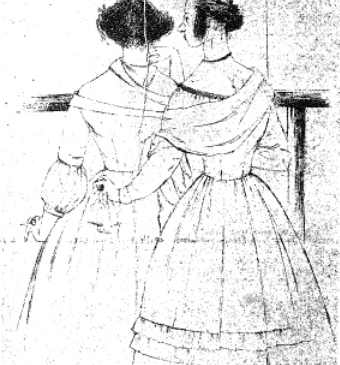Strona w trakcie tworzenia. Materiały się sukcesywnie uzupełniane.
Wystawa: Kobieta w walce o pokój

Barbara Gawdzik, Ilustracja do Gogola, reprodukcja za Tygodnik Powszechny 16/1952



Kobieta w walce o pokój
Miasto: Kraków
Instytucja: Pałac Sztuki
Kuratorka: Carlotta Bologna, Hanna Rudzka Cybisowa, Gustawa Langrodowa
Data: 8.3.1952
Zobacz listę artystek i prac - zobacz
Tekst kuratorski - zobacz
H.B. [Helena Blumówna], „Krakowska Kronika Plastyczna,” Tygodnik Powszechny 16/1952 - zobacz
ZPAP i LK przygotowują wystawę «Kobiety o kobietach» na Międzynarodowy Dzień Kobiet. Wystawa ta zobrazuje osiągnięcia kobiet w walce o pokój,” Echo Krakowskie 46 (1952)
Hanna Mortkowicz-Olczakowa, „Zmiany w krajobrazie,” Nowa Kultura 28 (1952)
Uroczysty przebieg dnia kobiet: Wystawa w Pałacu Sztuki, Dziennik Polski 60(1952) - zobacz
The only nation-wide all-women exhibition organised in that period was Kobieta w walce o pokój [Woman Fighting for Peace], organised in 1952, noteworthy, on the International Women’s Day, by Women's League[1]. Shortly after the war, the League received the status of an official organisation and absorbed other women's associations from the interwar period. It was directly dependent on the Women's Division of PZPR (Polish United Workers' Party) and depended on the governing party to a large degree[2]. Its goals did not reflect real women's needs, but rather assumptions of the party. Although the above-mentioned exhibition had a large scope, it also implicated people in close relations with the authorities. The idea of "fighting for peace" did not correspond with women's priorities at that time, it was not related to the topics women were interested in, and it had an ideological message resulting from a turbulent international situation. The peace campaign was tied to party goals, including industrialization, collectivization and the Six-Year Plan[3] in particular, success which was seen as also dependent on women’s commitment to work. The necessity of fulfilling these objectives was underlined at the First All-Polish League of Women Congress in 1951[4], and notably it was also emphasized in the curatorial text accompanying the show.[5] Moreover, the organizers of the exhibition arranged field visits to the workplaces, State Agricultural Enterprises and Production Cooperatives to enable women artists to establish relationships with work leaders [przodownice], who exceeded production norms and with rationalizers [racjonalizatorki] who were engaged in production improvements. Women's League wanted women artists to became involved in achieving the party leaders’ goals and was acting as state agent rather than on behalf of women artists, not commiting itself to change in their current position in the field of art.
Luiza Kempińska, “Kobieta w walce o pokój”, w: Wystawy sztuki kobiet w Polsce,
http://wystawykobiet.amu.edu.pl/wystawa/kobieta-w-walce-o-pokoj,47.html
[1] After the war, the organisation was called: Społeczno-Obywatelska Liga Kobiet (Social-Civic Women's League) and in September 1949 the name was changed to Women's League. See: Anna Nowakowska-Wierzchoś, Społeczno-Obywatelska Liga Kobiet (1945-1949) i Związek Kobiet Polskich im. Marii Konopnickiej we Francji (1944-1950) – dokumenty programowe [Social-Civic Women's League (1945-1949) and Maria Konopnicka Association of Polish Womrn in France (1944-1950) - program documents], in: "Komunizm: system–ludzie–dokumentacja' [Communism: System-People-Documentation], no. 2, 2013, p. 251-279.
[2] Refer to: Dariusz Jarosz, Idee, programy i realia: funkcje Ligi Kobiet w porządku instytucjonalnym Polski Ludowej (1945–1957) [Ideas, Programs and Reality: Functions of Women's League in the Institutional Order of the People's Republic of Poland (1945–1957)], in: „Działaczki społeczne, feministki, obywatelki...Samoorganizowanie się kobiet na ziemiach polskich po 1918 roku (na tle porównawczym)” [Social Activists, Feminists, Citizens... Self-Organisation of Women in Poland after 1918 (Comparison)], vol II, ed. Agnieszka Janiak–Jasińska, Katarzyna Sierakowska and Andrzej Szwarc, Neriton, Warsaw 2009.
[3] The Six-Year Plan was commenced in 1950 and concentrated on heavy industrionalisation.
[4] Alicja Musiałowa, Zadania kobiet polskich w walce o pokój i plan 6-letni [The goals of Polish Women in The Struggle for Peace and the Six-Year Plan], Proceedings from the First All-Polish League of Women Congress, in: „Nasza praca”, no. 6-7, 1951, p. 21-41. See also: Halina Rudnicka and ZGLK, Kobiety mówią o sobie [Women speak about themselves], Spółdzielnia Wydawniczo-Oświatowa Czytelnik, Warsaw 1952; Zofia Wasilkowska, Kobiety w walce o pokój [Women Fighting for Peace], Państwowe Wydawnictwo Popularno-Naukowe Wiedza Powszechna, Warsaw 1953.
[5] Carlotta Bologna, curatorial text for the exhibition Kobieta w walce o pokój [Woman Fighting for Peace], Pałac Sztuki, Cracow 1952.
